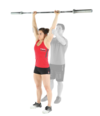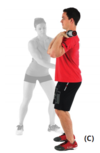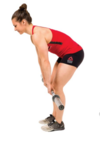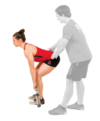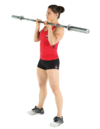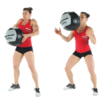The Nine Foundational Movements Flashcards
What are the nine foundational movements?
- Air squat, front squat, overhead squat
- Shoulder press, push press, push jerk
- Deadlift, sumo deadlift high pull, medical ball clean
What are the five common movement themes of the nine functional movements?
- Midline stability
- Posterior chain engagement
- Core-to-Extremity
- Full range of Motion
- Active Shoulder
Air squats
What are the 5 points of performance?
- Neutral Spine
- Weight on the heels
- Below parallel
- Line of Action
- Knee tracking
Air squats
What are the 5 common faults?
- Loss of neutral spine
- Weight shifting to the toes
- Improper depth
- Knees in
- Improper line of action
Air Squats
What is the issue and how to fix it?

Fault
Loss of a neutral position due to flexion in the lumbar spine.
Correction:
- Cue the athlete to lift the chest.
- Have the athlete raise the arms as he or she descends to the bottom of the squat.

Air Squats
What is the issue and how to fix it?

Fault
Weight on toes or shifting to toes.
Correction:
- Have the athlete exaggerate weight on the heels by lifting the toes slightly throughout the entire movement. (B)
- Give a tactile cue to push the hips back and down. (C)

Air Squats
What is the issue and how to fix it?

Fault
Not going low enough.
Correction:
- Cue “Lower!” and do not relent.
- Have the athlete squat to a target that places the hip crease lower than the knee to develop an awareness of depth. (D)

Air Squats
What is the issue and how to fix it?
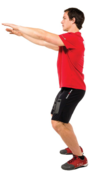
Fault
Improper line of action: hips do not travel back, knees move excessively forward placing weight on the toes.
Correction:
- Give a tactile cue to push the hips back and down.
- Block the knees’ forward travel with the hand at the initiation of the descent to encourage movement of the hips. (E)

Air Squats
What is the issue and how to fix it?

Fault
Knees not tracking in line with toes, which usually causes them to roll inside the feet.
Correction:
- Cue “Push your knees out” or “Spread the ground apart with your feet.”
- Use a target on the outside of the knee for the athlete to reach. (F)

Air Squats
What is the issue and how to fix it?

Fault
Immature squat: All points of performance are maintained but the athlete has to cantilever forward excessively onto the quads to maintain balance
Correction:
Squat Therapy: Set the athlete facing a wall or racked bar with a target at depth. Set him or her in the proper stance, with heels to the box, chest close to wall. Have the athlete squat to the box slowly, maintaining control and weight on the heels.

Define the “Frontal plane”

Front squat
What are the three points of performance?
- Grip
- Elbows high
- Frontal plane
Front squat
How to set up for the front squat?
- Shoulder-width stance.
- Loose fingertip grip on the bar.
- Hands just outside shoulders.
- Elbows high (upper arms parallel to the ground).

Front Squats
What is the issue and how to fix it?
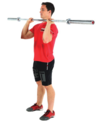
Fault
Improper rack position where the bar is not in contact with the torso.
Correction:
- Ensure the athlete has an open grip and the bar is resting on the fingertips.
- Cue “Elbows high!”
- Manually adjust the rack position. (A)

Front Squats
What is the issue and how to fix it?

Fault
Elbows drop during the squat.
Correction:
- Encourage the athlete to move their elbows away from the trainer’s hands. (B)
- Cue “Elbows up!” and encourage the athlete to lift the chest.

What are the three points of performance of the overhead squat?
- Overhead position
- Elbows extended
- Active shoulders
Overhead Squats
What are the common mistakes?
- Bar to far forward
- Inactive shoulders
Overhead Squats
What is the correct setup for the overhead squat?
- Shoulder-width stance.
- Shoulders push up into the bar.
- Arms extended.
- Wide grip on the bar (wide enough to perform a pass-through).
- Armpits face forward.

Overhead Squats
What is the issue and how to fix it?

Fault
Inactive overhead position due to flexed elbows and/or inactive shoulders.
Correction:
- Cue athlete to press the bar up.
- Use a tactile cue to push the elbows straight,
shoulders up, and armpits forward. (A)

Overhead Squats
What is the issue and how to fix it?

Fault
The bar moves forward of the frontal plane.
Correction:
Cue the athlete to press the bar up and pull it back over midfoot or slightly behind the frontal plane.

Shoulder Press
What are the four common faults?
- Loss of midleline stabilization
- Improper bar path
- Not overhead at finish
- Inactive shoulders, elbows bents
Shoulder Press
What are the four points of performance?
- Setup: Grip just outside the shoulders. and feet under the hips, and the elbows slightly in front of the bar.
- Neutral spine Maintain a stable midline throughout the movement.
- Vertical bar path: Need to move the head.
- Active shoulders: Continue pressing up into the bar at lockout.
Shoulder Press
What is the issue and how to fix it?

Fault
Overextending the spine with the ribs sticking out.
Correction:
- Have the athlete tighten the abdominals by pulling the rib cage down (be sure to check the overhead position again after this fix). (A)
- Have the athlete use a slightly wider grip if needed, until flexibility improves.

Shoulder Press
What is the issue and how to fix it?

Fault
The bar finishes forward of the frontal plane.
Correction:
- Cue the athlete to press up and pull back on the bar as it travels overhead.
- Use a tactile cue and gently push the bar back into the correct position. (B)

Shoulder Press
What is the issue and how to fix it?
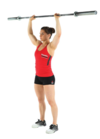
Fault
Elbows are bent or shoulders are not active.
Correction:
Cue “Press up!” and use a tactile cue to lock out the elbows and push the shoulders up.
